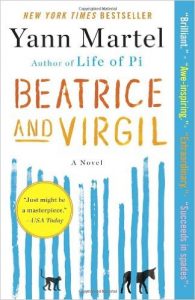Yann Martel’s Beatrice & Virgil
 I recently finished reading Yann Martel’s Beatrice & Virgil, and afterwards I was kind of speechlesslessly moved… and disturbed. But after the prickles in my skin smoothed and my fur unruffled, a couple of sleeps later… these thoughts came to me.
I recently finished reading Yann Martel’s Beatrice & Virgil, and afterwards I was kind of speechlesslessly moved… and disturbed. But after the prickles in my skin smoothed and my fur unruffled, a couple of sleeps later… these thoughts came to me.
One could say that it is ‘like’ Life of Pi in that it’s deep and philosophical… and… it has animals in it… but there the resemblance ends. Beatrice and Virgil is a darker book, and upon reflection, the key difference is that instead of being about me, it’s about you. And by that I mean that it’s ultimately about empathy. It’s a subtle and a quiet book.
One could say that it is ‘like’ Life of Pi in that it’s deep and philosophical… and… it has animals in it… but there the resemblance ends
Martel begins by introducing us to his narrator Henry, a writer not unlike Martel, we are led to believe, and through this sleight of hand, helps us to believe and empathize and get inside of Henry’s head and heart. Then takes us on a journey with Henry, getting to know first the characters in a play, Beatrice and Virgil, absorbing their remembrances and thoughts and feelings, until they too are like our own, eventually and literally ‘getting under our skin.’ Martel succeeds in a fresh, innovative and sneaky way, through a fiction inside a fiction, in helping every reader to empathize with Holocaust survivors in a way they likely haven’t done before, in a lasting way, and then he even manages to ‘help’ us empathize with the perpetrator of the Horrors, the old taxidermist, a Nazi war criminal, through his obsession, his consuming guilt and self-loathing, even through his cold detachment… and thank you, that’s not creepy.
Martel succeeds in a fresh, innovative and sneaky way, in helping every reader to empathize with Holocaust survivors in a way they likely haven’t done before, in a lasting way
You’ll say I’ve missed the point, that Martel meant this book and its subject matter to represent an allegory for the blind ignorant, cruel destruction and extermination by humankind of animalkind, and yes it manages to do that too, like an oroboros eating its own tail, it goes round and round, one meaning the other. It’s about the heartless destruction by man of all life, his own kind, other kinds… the planet… individual lives… relationships… families… pasts and futures… dreams and hopes… entire habitats and cultures… ultimately himself. Martel helps us feel these things, from the armature that underpins us to the markings on the surface of our fur, in such a way that we can never forget.
Martel helps us feel these things, from the armature that underpins us to the markings on the surface of our fur, in such a way that we can never forget
If that is not enough for a slim volume to accomplish, Martel’s book does one more thing. The author slyly and wittily announces his intentions at the outset through his puppet Henry by laying out his thesis- that while history can tell us what is real, only fiction can teach us what is true. And just like his panel of judges, we are not completely convinced. He then proceeds to prove it.

